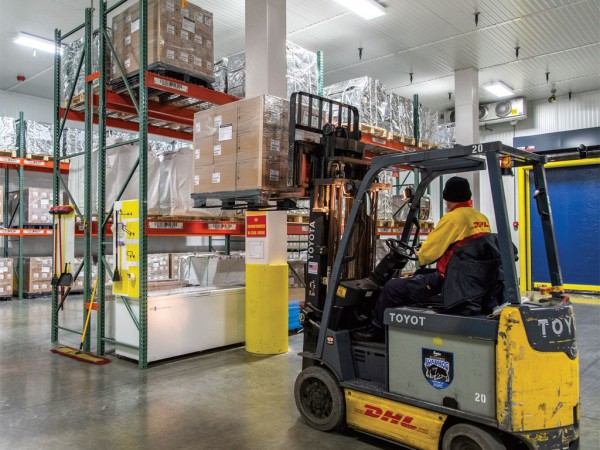With the rise in e-commerce has come an annual torrent of post-holiday returns. Millions of packages that flowed one-way through the supply chain to the consumer must now be turned and move back through the supply chain to the appropriate destination. No easy task for a logistics system largely built to deliver. But reverse logistics is not only a feature of the holidays e-commerce rush but an everyday challenge to the supply chain.
Holiday sales last year were estimated at $719 billion with most purchases made between early December and just before Christmas. In the preceding three-months the U.S. Census Bureau noted that 3rd Qtr. e-commerce increased 14.5% over the same period the year before and accounted for approximately 9.8% of total quarterly sales. It is estimated at the holiday peak, UPS, FedEx and the U.S. Postal Service were handling 72 million packages per day, as compared to the normal average of 45 million per day.
If You Can Buy It… You Can Return It
Relaxed return policies and this year’s wealth of e-commerce have contributed to a unique and growing trend in retail shopping. Among high-end retailers, Nordstrom, Macy’s, and Bloomingdales lead the field in easing their return policies. Online retailers like L.L. Bean, Land’s End and Amazon also offer easy returns. Even specialty shops such as Bath & Body Works, ULTA Beauty, and SEPHORA make it simple to give merchandise back.
RetailDive put the value of returns at about $400 billion. E-commerce apparel seems to command a large segment of returns. As Brendan Heegan, president of Boxzooka, a Jersey-based fulfillment center put it, “Lots of people will buy two of the same item, try on one and return the other, whereas in the store, they can touch and feel the article and are less likely to return the merchandise.” “Retailers will offer free returns on domestic orders,” he said, “but it’s more difficult to return international goods as the retailers make it harder for the consumer. The return is usually at their expense.”
Logistics providers carry a good bit of weight when it comes to processing and handling returns for the retail community. Boxzooka, for example, is a full-service fulfillment center for both e-commerce and smaller brick and mortar stores. They operate a 135,000 cu/ft. warehouse in Secaucus handling just over a million units of merchandise last year. “Our primary business is e-commerce, and most of that, about 75%, is apparel and accessories, with a smaller percentage about 15% in beauty aids and cosmetics and 10 other items,” Heegan said. “About, 95% of the returns we receive are from e-commerce orders that shipped directly out of our facility, to begin with. Another 5% of returned merchandise comes from department stores that we shipped product for originally.”

As the outsourcing operation for the vendor, Boxzooka inspects all return goods and either places it back in stock for resale or puts it on hold if damaged. Commenting on the nature of returns, Heegan said “returns are an ugly business for both the retailer and 3PL alike. We’ve built tools in our proprietary warehouse management systems that allow us to easily identify a return, the original order contents, and match them easily for fast processing”.
Integrated software allows retailers to coordinate inventory, order processing and returns with some of today’s leading e-commerce platforms, sixteen in all. Shopify, Magento, Amazon Prime, and Spring Systems to name a few, can be merged with data produced by the Boxzooka team. They can even customize a system if an off the shelf brand doesn’t meet a client’s needs.
DHL’s Logistics Control Tower
DHL Global Forwarding has been handling asset recovery for over 20 years. John Mugnaini is head of Domestic and Integrated Warehousing Services for the U.S. including Alaska and Hawaii. He noted, in the area of reverse logistics they work primarily with the engineering and technology sectors. One logistics solution called the “Logistic Control Tower” tracks freight across multiple platforms from warehouse to international and domestic transport. It performs a risk assessment to minimize delays and provides all direct and accessorial services connected with cargo movement.
Mugnaini explains the process as follows: “DHL has worked with multi-national customers on a number of projects focusing on reverse logistics. We offer one such customer, one of the top computer and printer manufacturers in the world, a Control Tower service serving as a single point of contact for asset recovery projects, recovery of freight, packaging of goods, returning freight and recycling of materials at specific facilities. DHL also offers this customer a local central control location for returns and recycling.” For a top engineering group, they offer what Mugnaini describes as a white glove service. “The service includes a Control Tower that helps with uncrating, debris removal, swaps, and returns. With a dedicated team of experts, DHL is able to provide efficient coordination of pickups and the tracking of shipments.”

Mugnaini noted their volume of return freight was greater last year than in 2017. He attributes this to growth in the residential business sector related to electronics warranties, repairs, replacements, and returns. When asked about the nature of return logistics Mugnaini said, “We see a greater focus on the customer experience, which means an overall better experience for the return process. Logistics companies will need to expand their services to meet the changing needs of the market, i.e. on-site packaging, (equipment) install and de-install services, as well as real-time visibility options.”
UPS Tackles the Return End Game
UPS handles everything from high-tech merchandise and parts, to apparel, shoes, and accessories. They are experts in the movement of department store merchandise, as well as health care products and medical devices. Jim Brill, Marketing Manager Reverse Logistics, noted, “UPS delivers 18 to 20 million outbound orders on a daily basis including a sizable volume for both brick-and-mortar retail stores and e-commerce merchants. With regard to returns, sometimes the shipper sends the wrong item and it needs to be returned or the buyer realizes they ordered the wrong color or have selected the wrong SKU when ordering. This all leads to the need for this merchandise to be returned.”
Brill estimated that UPS handles hundreds of millions of return packages each year. Aside from the December holidays, UPS sees smaller spikes in return activity during the year, usually around lesser holidays like Valentine’s or Memorial Day. Merchandise purchased during these periods may also need to be returned. “As an example, barbeque grills are popular around the Fourth of July and most people are adept at putting them together. However, some people out of sheer frustration just send them back.” As part of a complete freight management package, the expert handling of reverse logistics adds value to the overall customer experience.

“We are the major carrier of choice in the world of returns and reverse logistics,” Brill noted. “Returns are more complicated than outbound shipping and so our customers want us to service not only their return logistics but help them make gains in the processing of their returning merchandise. Our clients want to know what is coming back, what condition it’s in and what to do with it once returned. UPS Returns Manager and Optoro are great examples of how we are helping shippers with efficiency and returns data.”
Optoro is a sophisticated technology platform for integrating reverse logistics data. UPS has partnered with Optoro investing both resources and manpower to align itself with this platform in both the retail and technology sectors for sales and marketing. They recently rolled out a new product called UPS Returns Manager which helps customers to better integrate their return policy and their return process as presented to their clients.
Returns Business Returns
New Year buyers and sellers alike look to logistics providers to solve their return woes. Traditionally retailers utilize a combination of direct resale, wholesale, and liquidation to dispatch return stock. The holiday return business returns quickly in the wholesale markets. For example, RetailDive historically sees a 60% uptick in activity in the first quarter of the New Year. The most common items which move quickly to markdown are specialty kitchen items, goods seen on TV, seasonal products, toys, and trendy women’s clothing. Carriers such as UPS and logistics providers like DHL and Boxzooka are making the process less painful, providing buyer and seller a better overall return experience and in doing so taking the kinks out of the supply chain.



_-_127500_-_dce0870929d405d1e6aa1347b527bc595d03145c_lqip.jpg)
